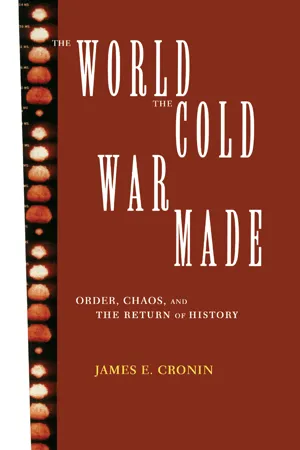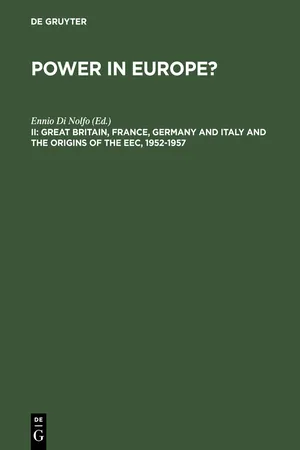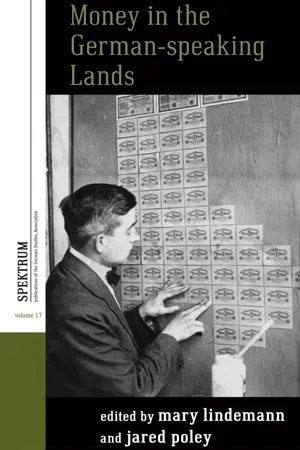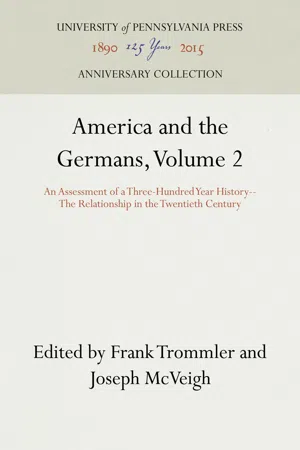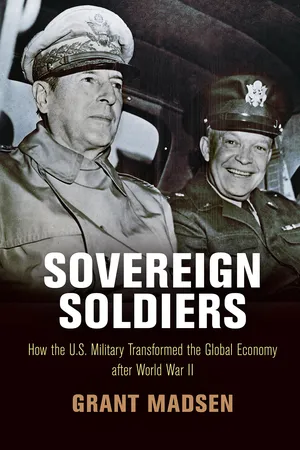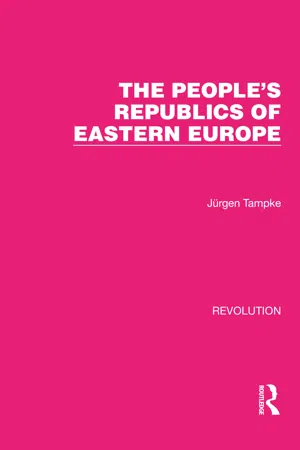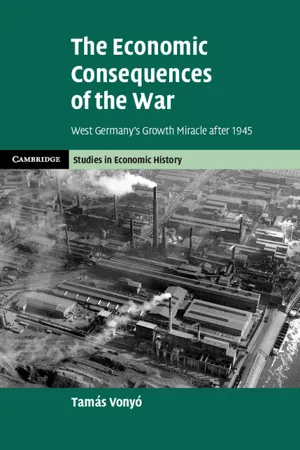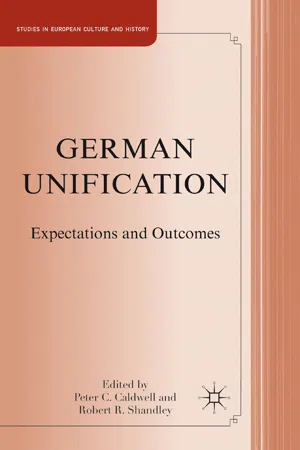History
German Economic Miracle
The German Economic Miracle refers to the rapid reconstruction and growth of the West German economy after World War II. This period of remarkable recovery, which occurred from the late 1940s to the early 1960s, was characterized by significant industrial production, export expansion, and a surge in living standards. The implementation of economic policies, such as the currency reform and the Marshall Plan, played a crucial role in this transformation.
Written by Perlego with AI-assistance
Related key terms
1 of 5
10 Key excerpts on "German Economic Miracle"
- eBook - ePub
The World the Cold War Made
Order, Chaos and the Return of History
- James E. Cronin(Author)
- 2021(Publication Date)
- Routledge(Publisher)
Betriebsverfassungsgesetz (Works Constitution Act) of 1952 was, however, much weaker than the earlier legislation. The unions got at best a third of the slots on boards of directors, and works councils had a much restricted mandate.Labor, then, was poorly positioned in the early years of the republic. Lacking effective control over the market for labor and with but a weak voice within industry, the unions were unable to make significant progress toward their proclaimed goal of economic democracy. Ironically, the weakness of labor undoubtedly aided economic recovery and, in the long run, may have been of more benefit to workers than greater representation or higher wages granted in the context of a less rapidly growing economy. The Wirtschaftswunder was a classic instance of export-led growth: the rate of growth of exports (13.5 percent) far outpaced that of the economy (8.9 percent) and of private consumption (7.8 percent) in the 1950s.26 The pattern continued, enabling the German share of world exports to grow from 3.7 percent in 1950 to 10 percent in 1970.27 Part result and part cause of this process, productivity rose faster than wages and unit labor costs went down steadily. Stable or declining costs were an ongoing spur to exports and led to further growth.Economic growth ultimately led to rising real incomes and increased consumption, but with a considerable lag. The economic miracle was in this crucial respect built upon the willingness, coerced or freely granted, of workers to postpone improvements in the standard of living. Even so, the success of the miracle was not guaranteed by the labor market or by the institutional framework of the “social market economy.” It rested as well on two further foundations. First, growth resumed in the early 1950s due largely to the boom in world trade sparked by the Korean War. Second, Germany was better able to take advantage of the boom because of the enormous spare capacity of industry. A good portion of the capital stock was a product of the Nazis’ incredibly successful buildup of the war economy. As of 1950, manufacturing industry was utilizing only three-quarters of its capacity and was therefore capable of rapid expansion. Expansion was also made possible by a more than ample supply of skilled and trained labor at what amounted to a bargain price.28 There has been some reluctance to acknowledge the contribution of U.S. military spending to German economic revival and even more resistance to the notion that Nazi investment policies laid the basis for the Wirtschaftswunder. Erhard himself, for example, argued strongly that the Korean War hurt rather than helped the economy, and that it was the institutional framework of free enterprise, not the de facto Keynesian stimulus of the Korean War that was responsible for long-term growth.29 - Ennio Di Nolfo(Author)
- 2012(Publication Date)
- De Gruyter(Publisher)
Volker Berghahn has even spoken 65 BDIA/13, Sitzungsprotokolle 1960: Anlage 3 zur Niederschrift über die BDI-Geschäftsführ-erkonferenz, April 8, 1960. 66 Abelshauser, Wirtschaftsgeschichte, p. 8. 196 Werner Bührer and Hans-Jürgen Schröder of an Americanization oí the West German economy. 67 Taken as a whole, the German Economic Miracle was an important factor in securing equal rights again and ultimately in taking over an economically based leadership role in the Western part of the Continent. The growing self-awareness, par-ticularly of the business elite, is testimony to this. In the first half of the 50s the economy as an instrument of foreign policy played such a big part, additionally, because the debate on the modalities of a West German defence contribution dragged on until the mid-50s. The calculation, repeatedly formulated by politicians and academics in the Federal Republic, of using West Germany's economic strength as an instrument towards a political restoration, was successful for both structural and conjunctural reasons. The framework conditions for foreign policy were certainly likewise an important prerequisite: this is particularly true of US foreign policy, since, for political and geo-economic reasons, West Germany after the Second World War was at the core of Washington's European policy. From the viewpoint of German business people and politicians, it was legitimate to force economic recovery and employ German economic potential to secure equal foreign-policy rights again. The employment of economic policy as an instrument of foreign policy was all the more successful the less this political dimension was publicly discussed. How successful this strategy ultimately was and is, is proved by the fact that the Federal Republic was repeatedly called, not only by journalists but also in academic analyses, a world power against its will.- eBook - ePub
- Michael Balfour(Author)
- 2004(Publication Date)
- Routledge(Publisher)
In addition the return obtainable on investment is likely to rise, making it more attractive in comparison with other uses of money and hence stimulating it. The essence of the German ‘miracle’ was that at a time when world demand was high, German industry found itself with spare capacity, the right products and relatively low costs, so that exporting was easy and profitable, and hence popular. Once this export-led expansion got under way, the prospect of making profits attracted investment into export industries whose growing earnings made it easy to pay for all the imports which increasing manufacturing for export involved. The pool of unemployed, continually refilled until 1961 by migrants from East Germany, for a long time prevented shortage of labour from constricting output. Thanks to the high rate of investment, production grew at a rate which allowed for ample increases in prices and wages without inflation. The exchange rate remained favourable (in spite of being devalued less than most other European currencies in 1949 and being up-valued in 1961 and 1969) and the costs of West Germany’s competitors mostly rose faster than hers did (to say nothing of the fact that she sold on quality and servicing as much as on price) so that she could afford increases without pricing herself out of the market. All in all, she was in the exceptional and fortunate position of a ‘virtuous spiral’ (such as Britain enjoyed between 1750 and 1850). Neither the old Reichsmark nor the new Deutschmark was a ‘reserve currency’ and West Germany was not under any obligation to provide other countries with capital. Indeed the authorities put up interest rates to check home demand with the result that, in spite of a big export surplus, money flowed into rather than out of the country - eBook - PDF
- Mary Lindemann, Jared Poley, Mary Lindemann, Jared Poley(Authors)
- 2017(Publication Date)
- Berghahn Books(Publisher)
16 Such a dogmatic and ideological approach would very soon come to haunt the Minister of Economics; his inten-tion to finance the long-term investment necessary for the reconstruction with Marshall Plan counterpart funds did not materialize before the autumn of 1949 due to lack of funds. The myth of the Wirtschaftswunder thus developed in three stages: the first one was visible immediately with the currency reform and the full shop windows when previously hoarded goods or those traded on the black market became available again. The second stage was the August 1949 general election result, which, due to Erhard’s Düsseldorf Principles and despite significant economic setbacks, resulted in a narrow Christian Democratic Union victory. This allowed Erhard not only to stay in office but with the help of his excellent press contacts and sponsoring from industry, to continue a massive propaganda campaign for the social market economy in the mass media. 17 When the economic boom arrived by 1952–53, it was export driven and not really of Erhard’s making, but it served as German exculpation from the Nazi crimes and the emergence of the Wir-sind-wieder-wer mentality. There was little interest in the collective memory to remember the “bad times” before 1945 or the devastation 1945–50, as neither fitted the image of “good Germans” and the heroic legend of German economic recovery from ruins. The Kreditanstalt für Wiederaufbau American military governor and Marshall Plan administrators were disap-pointed and annoyed with the German reliance, even fixation, on Marshall Plan funds. In his frustration, General Clay, the U.S. military governor in Germany, went so far as to call the existence of the Marshall Plan counterpart funds the “biggest evil” for the German economy because, as he explained, he had not seen a single German reconstruction proposal that was not based on those funds. - eBook - PDF
- Richard Sakwa, Anne Stevens(Authors)
- 2012(Publication Date)
- Red Globe Press(Publisher)
The chapter shows that although the pressures for change have produced greater market orientation in all the various national versions of capitalism and belt-tightening in all the social security and welfare systems, significant differences in both economic organization and welfare systems remain between European countries. The miracle of post-war economic growth After 1950 European countries experienced phenomenal growth and, as Adam Smith predicted in the passage cited at the head of the chapter, their populations benefited from tremendous improvement in their standard of living, although growth was faster between 1950 and the mid-1970s than after. In The annual labour of every nation is the fund which originally supplies it with all the necessaries and conveniencies of life which it annually consumes, and which consist always either in the immediate produce of that labour, or in what is purchased with that produce from other nations. According, therefore, as this produce, or what is purchased with it, bears a greater or smaller proportion to the number of those who are to consume it, the nation will be better or worse supplied with all the necessaries and conveniencies for which it has occasion. Adam Smith, An Inquiry Into The Nature And Causes Of The Wealth Of Nations , 1776, Introduction CHAPTER 8 The European Economy 1950 to 2010: the Miracle of Growth and the Sources of Wealth VIVIEN A. SCHMIDT The miracle of post-war economic growth 172 The explanation of growth 176 The challenges of growth 186 Western Europe, wealth provided people not only with the basics, such as running water and flush toilets, but also with the amenities to make every-day life easier – televisions, telephones and cars, followed by mobile phones and even personal computers. - eBook - PDF
America and the Germans, Volume 2
An Assessment of a Three-Hundred Year History--The Relationship in the Twentieth Century
- Frank Trommler, Joseph McVeigh, Frank Trommler, Joseph McVeigh(Authors)
- 2018(Publication Date)
9 The West German political economy, in effect, would emerge as one of the triumphs of the Truman compromise. The struggles over German economic organization and the defeat of socialist alternatives helped encourage a positive assessment of Ger- Production and Rehabilitation many's productive capacity. So too did the rush of events toward the Cold War. By the end of 1947 a revived level-of-industry ceiling on Ger-man economic revival (allowing for 1936 levels of production rather than those of 1932) suggested that the United States and Britain badly wanted the Germans to produce as much as they could. 10 The contro-versies within the military government led to the ouster of those who feared that industrial concentration was likely to revive fascism. The American announcement of the Marshall Plan and the response to the multiple economic and political crises of 1947-48 established that German economic recovery would count in American eyes as a posi-tive step toward national rehabilitation. Germany was entrusted with a positive mission of production. In its wake would come the country's recovery of sovereignty and its rehabilitation. Announcement of the Marshall Plan was triggered, in the short run, by the European economic setbacks of late 1946 and early 1947 and by the failure of the Moscow Conference to restore four-power co-operation in administration of Germany. The Marshall Plan was inno-vative in its idea of taking Western Europe as a unit and assigning Western Germany a role within that unit. Once German economic po-tential was envisaged as a contribution to a broader region, the restric-tions on the country's capacity to produce seemed self-defeating. Of course, such criticism of occupation policy as Herbert Hoover's report of spring 1947 may have spurred such a change in policy faster than otherwise. - eBook - PDF
Sovereign Soldiers
How the U.S. Military Transformed the Global Economy After World War II
- Grant Madsen(Author)
- 2018(Publication Date)
- University of Pennsylvania Press(Publisher)
Chapter 7 A German “Miracle” While restoring Germany’s domestic economy remained a top priority for Lucius Clay and Joseph Dodge through 1946, this effort raised a second important question: how would Germany, in turn, fit into the global econ-omy? The Bretton Woods conference had aimed to establish “a stable and orderly system of international currency relationships.” 1 Yet Henry Mor-genthau had operated from the same assumptions at Bretton Woods that he used for JCS 1067. In each case, he assumed (following his adviser Harry Dexter White) that European countries (and especially Germany) would be in a much better economic position after the war than, in fact, they were. Moreover, he assumed that Europe (and particularly Germany) would likely exploit American generosity, and so he remained guarded. 2 Almost as soon as the war ended the world experienced what came to be called “the dollar gap.” Global demand for American goods exceeded American demand for global goods to the tune of $7.8 billion in 1946 and $11.6 billion in 1947. By running trade deficits with the United States, other countries could never earn extra dollars to build a safe reserve. As a conse-quence, European countries were forced to ignore the Bretton Woods agreements and impose exactly the kind of import and exchange controls the agreements had hoped to make obsolete. 3 The Bretton Woods agree-ments had unintentionally recreated the same unstable dynamic that existed at the end of World War I, where Europe once again could only get working capital by borrowing or begging from the United States. Increas-ingly, Washington officials realized that American aid, grants, and loans would have to continue for some time, a realization that came to its apothe-osis in the Marshall Plan. 4 Harry Truman appointed George Marshall as his secretary of state in January 1947, at the moment Europe’s economy had reached its nadir. Inflation ravaged nearly every nation there. Production lagged. The - eBook - ePub
- Jürgen Tampke(Author)
- 2022(Publication Date)
- Routledge(Publisher)
5 THE GERMAN DEMOCRATIC REPUBLIC: ECONOMIC MIRACLE?For the GDR the 1950s continued to be a decade beset with difficulties. The divided Germany in the heart of Europe became the centre of the West-East confrontation not only in terms of Cold War arguments about reunification and Berlin but also in terms of outright economic competition. Here, in full view of the world, one part of Germany was undergoing reconstruction along capitalist lines while the other followed a socialist course. Not surprisingly it was the GDR government’s avowed aim not only to match but indeed surpass the economic performance of West Germany. There was no chance for this to happen quickly.1 The vastly different starting conditions soon ensured that the Federal Republic surged ahead. This is not to say that the GDR’s economic performance was unimpressive. The contrary was true. With relief from the burden of reparations and with the transfer of the Soviet-run joint stock companies in 1953,2 the GDR economy maintained a steady growth rate. The target figures for the first five-year plan were largely fulfilled and in the wake of the reforms following the July 1953 confrontation, living conditions by 1955 had risen by one third compared to 1950, although there still remained a considerable shortage of consumer goods. The second five-year plan for the years 1956-60 specified an increase in gross national production of 55 per cent. Priority was given to the development of lignite, power and chemical industries. Plan targets were completed by 1958, two years ahead of schedule. The most notable achievement was the construction of the Kombinat Schwarze Pumpe which became the world leader in the production of brown coal. Production of consumer goods was also increased and the overall ‘surprisingly favourable economic development’3 - eBook - PDF
The Economic Consequences of the War
West Germany's Growth Miracle after 1945
- Tamás Vonyó(Author)
- 2018(Publication Date)
- Cambridge University Press(Publisher)
This role of the Marshall Plan adds a European dimension to post-war recovery in West Germany, inasmuch as the resources that German industry could provide were vital for the implementation of the reconstruction and development plans of neighbouring countries. After the end of World War II, the United States dominated the world economy. This transformation was reflected in the critical dollar shortage caused by the lopsided dependence of European countries on American imports (Buchheim 1990, 99). The temporary absence of German cap- ital goods from continental markets was a prime reason for the large European deficit in transatlantic trade. From the 1880s until World War II, the United States, the United Kingdom, and Germany had accounted for approximately 60 per cent of international trade in manufactured goods in roughly equal proportions. Their dominance was even more striking in the export of machine tools. Since, after the war, Britain had little spare production capacity, only American suppliers could substitute for German machinery exports. Therefore, reintegrating West Germany into the international division of labour presented the only viable solution to securing the foundations of sustainable economic growth in Europe (Milward 1991, 453–4). One of the major aims of the European Cooperation Act was the recon- struction of pre-existing trade relations between European states, which Washington considered to be the fist step towards the creation of a global economic system free of trade barriers. At the convention of the OEEC 5.2 The Marshall Plan in Germany 199 199 on 16 April 1948, the member states unanimously committed to an international payments system and to the abolition of barriers to trade and capital flows among the participating nations. - eBook - PDF
German Unification
Expectations and Outcomes
- P. Caldwell, R. Shandley(Authors)
- 2011(Publication Date)
- Palgrave Macmillan(Publisher)
Helmut Kohl struck a chord with the East German 122 / irwin l. collier electorate that resonated a shared hope that the postwar (West) German Economic Miracle might indeed be repeated. The ideological (in the best sense of the word) foundation for this hope was the doctrine of the Social Market Economy à la Ludwig Erhard. It can be distilled into three sub- doctrines: (1) hard money, (2) private enterprise disciplined by competitive markets, and (3) soft hearts reflected in burden sharing between the more and less fortunate members of society. Each of these components served as a pillar for the Treaty of Monetary, Economic, and Social Union that went into effect on July 1, 1990. What did the timetable of convergence between the East and West German economies appear to be to those confident enough to identify milestones of convergence and publicly announce esti- mated times of arrival? Figure 5.1 of this chapter plots a set of early forecasts of the degree of convergence between real per capita gross domestic product (GDP) in East and West Germany at particular points in time following German unifi- cation in 1990. 2 Three of the forecasts (1, 3, and 4) involved dates when East German per capita output was expected to converge with that of West Germany. To compare these forecasts with the four forecasts 3 represented by the points (2, 5, 6, and 7) for dates with incomplete convergence, paths for East German relative real per capita GDP have been drawn reflecting different hypothetical average rates of growth of real per capita GDP in East Germany from a low of 3 percent to a high of 9 percent per year. In contrast, the measured average rate of growth of West German real per capita GDP was only 0.65 percent per year over the period 1991–2009. This same rate has been extrapolated forward to 2030 to calculate the convergence paths for each of the hypothetical growth rates identified in the figure for East Germany.
Index pages curate the most relevant extracts from our library of academic textbooks. They’ve been created using an in-house natural language model (NLM), each adding context and meaning to key research topics.
